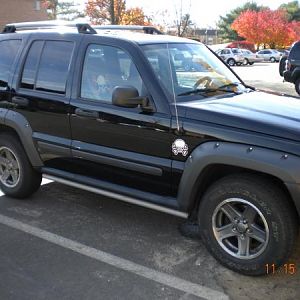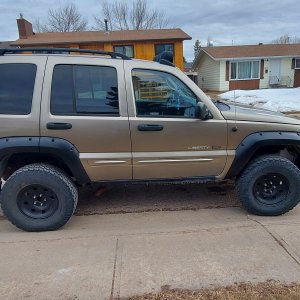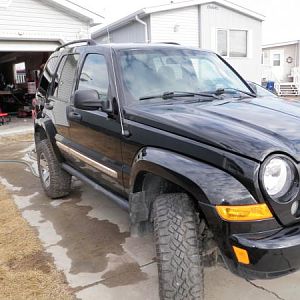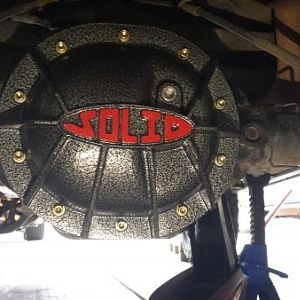This is an effort to share experience and knowledge related to replacing a Liberty 3.7L engine specifically for a 2003, but I am 99.7% confident that it also applies to 2002 and 2004.
Theoretically, this checklist should also apply to *all* Chrysler PowerTech 3.7L V6 motors regardless of vehicle (find compatibility list here: https://en.wikipedia.org/wiki/Chrysler_PowerTech_engine ), but there are going to be nuances regarding how certain parts (in the list below) map to a particular model and/or/year.
If you buy a reman engine, the vendors generally offer an "Complete Installation Kit", which is supposed to include everything you need to swap the engine. There is no guarantee that such a kit has reliable parts. If it is an option, do not buy it and spend the saved money on the parts listed below.
Only buy parts from the following Manufacturers. Be careful about Amazon "OEM" parts because it is mostly chinese bootleg garbage, visually identical but functionally trash, you will end up buying the recommendations below anyway, and chinese hustlers will laugh all the way to the bank. True parts will be in sealed Manufacturer packaging.
1. Mopar, wherever possible but a lot of items are obsolete and unavailable, in which case Crown is excellent.
2. Crown Automotive, which is explicitly Mopar OEM and readily available through Quadratec ( https://www.quadratec.com/ )
3. Bosch (example: fuel injectors)
4. NGK (example: copper spark plugs)
The following list is your installation checklist. If you are going to do this right, there are (a) required items, (b) recommended items, (c) and troubleshooting items.
The items you can replace easily have an asterisk (*), the items you can replace with some mechanical tinkering and a couple of hours have a pound sign (#), the items best left to a garage have a dollar sign ($).
Strongly recommend you follow the list of required/recommended entirely because if you are replacing an engine for a 2002-2004, that engine and everything hanging off of it is past logical/realistic/statistical end of life. There is not one mechanical item attached to a 2002-2004 Liberty that has a life expectancy past 150K miles. So even if you score a low mile Liberty that is ripe for a new drivetrain, the required/recommended items will minimize downstream frustration/confusion.
Download the KJ Repair Manual (you can find it out here on jeepkj.com), and look up the various components listed below.
New Sensors REQUIRED:
1. Oil pressure (OPS) *
2. Camshaft (CPS) $
3. Crankshaft (CKP) $
4. Intake Air Temp (IAT) #
5. Mass Air Pressure (MAP) #
6. Coolant Temperature (CTS) #
7. Throttle Position (TPS) *
8. O2 sensors #
Filters, Pumps, Valves REQUIRED:
9. PCV * NOTE: You must be very careful about disconnecting the old PCV, READ THE MANUAL
10. Crankcase Breathers (qty: 2) *
11. Intake Air Control Valve/Motor (IACV/IACM) *
12. Evap Canister Purge Valve *
13. Air Filter *
14. Oil Filter (next oil change)
Fuel Ignition REQUIRED.
15. Spark Plugs * MAKE SURE ALL 6 MATCH, copper, NGK is excellent
16. Ignition Coils * MAKE SURE ALL 6 MATCH, Mopar or Crown
17. Fuel Injectors $ DO NOT BUY REMAN INJECTORS, BUY NIB, and MAKE SURE ALL 6 MATCH, Mopar or Bosch (you can do this but you need a special hose-connector tool to remove the fuel rail and there is a serious threat of damage due to lack of experience with such things. Let a garage do it.)
RECOMMENDED replacements if you have not done so in a while
17. New battery * Buy a premium battery with high amps. Autozone has great warranties.
18. New alternator * Buy a premium alternator, not "good enough". Again, Autozone has great warranties.
19. New Relays in PDC *
That's it. However you may still have issues. Once you have done everything above, but still have problems like weird phantom rough engine behavior, read on. The following is only recommended if you finish the swap, do EVERYTHING above, and have engine related issues.
TROUBLESHOOTING replacement items:
20. Bad PCM. A lot of people have cured engine problems with a new PCM. Buy from Flagship 1 (lifetime warranty, rock solid, good Customer Service). If you still have the original PCM, this is a worthwhile investment anyway because a PCM is a computer, and I have never had any kind of computer last more than 10 years. Have you?
If a new PCM makes no difference in engine behavior, the only remaining culprits can be Electrical or Fuel Line.
21. Confirm that you are getting strong signal and power to the Fuel Injectors and/or Ignition Coils.
a. Any garage can check the power going to your Fuel Injectors and Coils. Breaks and shorts are distinct possibilities.
b. Make sure steady power is making it to the cylinders. You can DIY with a noid light, or have a garage electrician do it.
c. Make sure that *all* connector housings on *all* sensors, injectors, coils, intake air control motor/valve, evap solenoid, etc are intact and able to lock.
d. If there are any broken locking tabs anywhere, remove the connector and splice/heatshrink a new pigtail.
e. The "nuclear option": I did overkill by completely replacing the entire circuit for my FIs and ICs because I suspected a short somewhere on either one/other/both, so I fabricated 1 bypass harness for FIs and 1 bypass harness for the ICs all the way from the PCM and the PDC using unspliced wires. If you decide to do the same, see my "How to" for fabricating bypass wire harnesses for (a) Fuel Injectors and (b) Ignition Coils. All part sources and instructions are included, read the whole thing, take your time, do it right.
Irregular fuel delivery will make an engine misbehave. Fuel line troubleshooting is expensive and time consuming. The following requires dropping the fuel tank, but could be done in a driveway in a few hours. I suspected a possible fuel delivery problem on my KJ, but it turned out to be something else. You may not be as lucky, and if so you have my sympathy.
Anything except the Fuel Pump itself is relatively simple but time consuming.
HOWEVER, if you are ultimately forced to replace the fuel pump, there is a specialized seal-ring that is obsolete and only available from a salvage yard, which makes working on the fuel tank a significant risk, but replacement is possible.
If you drop the tank and the ring is corroded, find a complete salage yard replacement for the entire tank and everything hanging off of it. If you are comfortable with dropping a fuel tank and going DIY, everything other than the fuel pump itself is external to the tank and very easily accessible once the tank is detached. The basics are:
22. Evap Fuel Vapor Canister #
23. Fuel Filter $
24. Leak Detection Pump $
25. Fuel Flow Management Valve $
26. Fuel Pump $ + RISK
***The "significant risk" regarding the Fuel Pump***
a. There is a specialized fuel tank seal-ring that is obsolete and only available from a salvage yard.
b. Nobody manufactures these things and this is a car-killer if you need one and cannot track one down. This stupid, specialized seal-ring is the greatest risk when dealing with the fuel system. If the Fuel Pump goes bad, you must be able to either reuse or replace the existing seal-ring. No ring, no fuel pump, no fuel, no Liberty.
c. I kept vigilant when prowling the yards for other parts, and I lucked out and found a garage-kept 2003 at a local yard.
d. I detached all of the hoses and electrical connectors from the tank, cut the 2 straps and removed the entire tank and everything attached to it, with the old fuel pump still sealed inside, from the vehicle and brought it home.
e. This way I can wrangle the tank on a workbench and salvage the valuable ring carefully without wrecking it.
The above info took months of research, and trial and error, and I hope it helps someone down the line. If any clarification is needed, ping this thread and I will do my best to help out.
Theoretically, this checklist should also apply to *all* Chrysler PowerTech 3.7L V6 motors regardless of vehicle (find compatibility list here: https://en.wikipedia.org/wiki/Chrysler_PowerTech_engine ), but there are going to be nuances regarding how certain parts (in the list below) map to a particular model and/or/year.
If you buy a reman engine, the vendors generally offer an "Complete Installation Kit", which is supposed to include everything you need to swap the engine. There is no guarantee that such a kit has reliable parts. If it is an option, do not buy it and spend the saved money on the parts listed below.
Only buy parts from the following Manufacturers. Be careful about Amazon "OEM" parts because it is mostly chinese bootleg garbage, visually identical but functionally trash, you will end up buying the recommendations below anyway, and chinese hustlers will laugh all the way to the bank. True parts will be in sealed Manufacturer packaging.
1. Mopar, wherever possible but a lot of items are obsolete and unavailable, in which case Crown is excellent.
2. Crown Automotive, which is explicitly Mopar OEM and readily available through Quadratec ( https://www.quadratec.com/ )
3. Bosch (example: fuel injectors)
4. NGK (example: copper spark plugs)
The following list is your installation checklist. If you are going to do this right, there are (a) required items, (b) recommended items, (c) and troubleshooting items.
The items you can replace easily have an asterisk (*), the items you can replace with some mechanical tinkering and a couple of hours have a pound sign (#), the items best left to a garage have a dollar sign ($).
Strongly recommend you follow the list of required/recommended entirely because if you are replacing an engine for a 2002-2004, that engine and everything hanging off of it is past logical/realistic/statistical end of life. There is not one mechanical item attached to a 2002-2004 Liberty that has a life expectancy past 150K miles. So even if you score a low mile Liberty that is ripe for a new drivetrain, the required/recommended items will minimize downstream frustration/confusion.
Download the KJ Repair Manual (you can find it out here on jeepkj.com), and look up the various components listed below.
New Sensors REQUIRED:
1. Oil pressure (OPS) *
2. Camshaft (CPS) $
3. Crankshaft (CKP) $
4. Intake Air Temp (IAT) #
5. Mass Air Pressure (MAP) #
6. Coolant Temperature (CTS) #
7. Throttle Position (TPS) *
8. O2 sensors #
Filters, Pumps, Valves REQUIRED:
9. PCV * NOTE: You must be very careful about disconnecting the old PCV, READ THE MANUAL
10. Crankcase Breathers (qty: 2) *
11. Intake Air Control Valve/Motor (IACV/IACM) *
12. Evap Canister Purge Valve *
13. Air Filter *
14. Oil Filter (next oil change)
Fuel Ignition REQUIRED.
15. Spark Plugs * MAKE SURE ALL 6 MATCH, copper, NGK is excellent
16. Ignition Coils * MAKE SURE ALL 6 MATCH, Mopar or Crown
17. Fuel Injectors $ DO NOT BUY REMAN INJECTORS, BUY NIB, and MAKE SURE ALL 6 MATCH, Mopar or Bosch (you can do this but you need a special hose-connector tool to remove the fuel rail and there is a serious threat of damage due to lack of experience with such things. Let a garage do it.)
RECOMMENDED replacements if you have not done so in a while
17. New battery * Buy a premium battery with high amps. Autozone has great warranties.
18. New alternator * Buy a premium alternator, not "good enough". Again, Autozone has great warranties.
19. New Relays in PDC *
That's it. However you may still have issues. Once you have done everything above, but still have problems like weird phantom rough engine behavior, read on. The following is only recommended if you finish the swap, do EVERYTHING above, and have engine related issues.
TROUBLESHOOTING replacement items:
20. Bad PCM. A lot of people have cured engine problems with a new PCM. Buy from Flagship 1 (lifetime warranty, rock solid, good Customer Service). If you still have the original PCM, this is a worthwhile investment anyway because a PCM is a computer, and I have never had any kind of computer last more than 10 years. Have you?
If a new PCM makes no difference in engine behavior, the only remaining culprits can be Electrical or Fuel Line.
21. Confirm that you are getting strong signal and power to the Fuel Injectors and/or Ignition Coils.
a. Any garage can check the power going to your Fuel Injectors and Coils. Breaks and shorts are distinct possibilities.
b. Make sure steady power is making it to the cylinders. You can DIY with a noid light, or have a garage electrician do it.
c. Make sure that *all* connector housings on *all* sensors, injectors, coils, intake air control motor/valve, evap solenoid, etc are intact and able to lock.
d. If there are any broken locking tabs anywhere, remove the connector and splice/heatshrink a new pigtail.
e. The "nuclear option": I did overkill by completely replacing the entire circuit for my FIs and ICs because I suspected a short somewhere on either one/other/both, so I fabricated 1 bypass harness for FIs and 1 bypass harness for the ICs all the way from the PCM and the PDC using unspliced wires. If you decide to do the same, see my "How to" for fabricating bypass wire harnesses for (a) Fuel Injectors and (b) Ignition Coils. All part sources and instructions are included, read the whole thing, take your time, do it right.
Irregular fuel delivery will make an engine misbehave. Fuel line troubleshooting is expensive and time consuming. The following requires dropping the fuel tank, but could be done in a driveway in a few hours. I suspected a possible fuel delivery problem on my KJ, but it turned out to be something else. You may not be as lucky, and if so you have my sympathy.
Anything except the Fuel Pump itself is relatively simple but time consuming.
HOWEVER, if you are ultimately forced to replace the fuel pump, there is a specialized seal-ring that is obsolete and only available from a salvage yard, which makes working on the fuel tank a significant risk, but replacement is possible.
If you drop the tank and the ring is corroded, find a complete salage yard replacement for the entire tank and everything hanging off of it. If you are comfortable with dropping a fuel tank and going DIY, everything other than the fuel pump itself is external to the tank and very easily accessible once the tank is detached. The basics are:
22. Evap Fuel Vapor Canister #
23. Fuel Filter $
24. Leak Detection Pump $
25. Fuel Flow Management Valve $
26. Fuel Pump $ + RISK
***The "significant risk" regarding the Fuel Pump***
a. There is a specialized fuel tank seal-ring that is obsolete and only available from a salvage yard.
b. Nobody manufactures these things and this is a car-killer if you need one and cannot track one down. This stupid, specialized seal-ring is the greatest risk when dealing with the fuel system. If the Fuel Pump goes bad, you must be able to either reuse or replace the existing seal-ring. No ring, no fuel pump, no fuel, no Liberty.
c. I kept vigilant when prowling the yards for other parts, and I lucked out and found a garage-kept 2003 at a local yard.
d. I detached all of the hoses and electrical connectors from the tank, cut the 2 straps and removed the entire tank and everything attached to it, with the old fuel pump still sealed inside, from the vehicle and brought it home.
e. This way I can wrangle the tank on a workbench and salvage the valuable ring carefully without wrecking it.
The above info took months of research, and trial and error, and I hope it helps someone down the line. If any clarification is needed, ping this thread and I will do my best to help out.










![102109 1223[01]](/data/xfmg/thumbnail/2/2279-7b91dc5afd9396823de56ed34464f457.jpg?1623784618)

